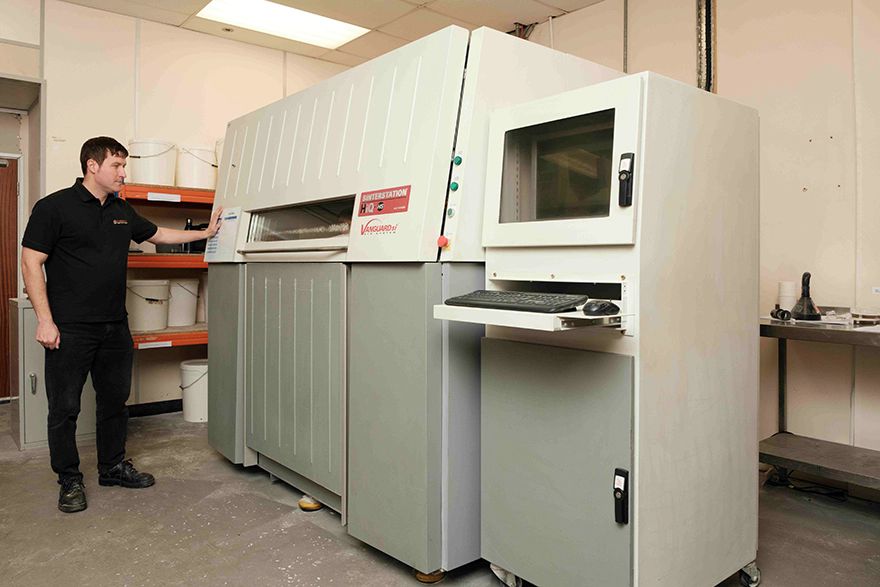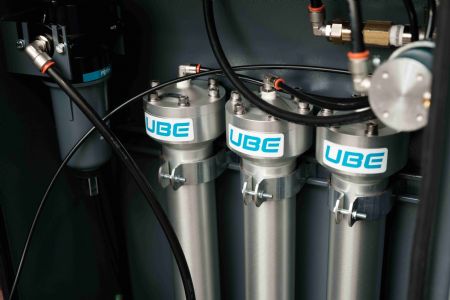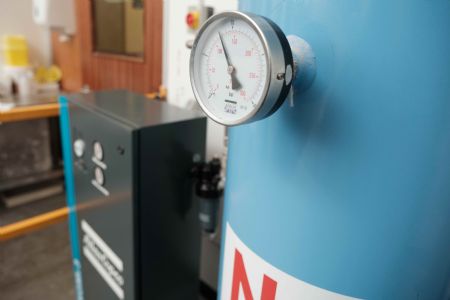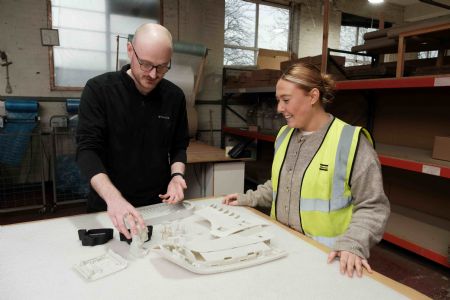 An SLS machine producing 3-D printed models. A stable and reliable nitrogen supply is crucial for its operation
An SLS machine producing 3-D printed models. A stable and reliable nitrogen supply is crucial for its operationDarlington-based
Paragon Rapid Technologies Ltd manufactures a wide variety of precision-engineered parts using a range of CNC and 3-D printing technologies at its facility near
Teesside International Airport. The company recently needed to replace its ageing on-site nitrogen generator with a new model that would be more efficient and achieve the high purity required in its selective laser sintering process, but there was an interesting proviso. The 3-D printing operation occupies a building that dates back to the 1940s, and the electricity supply can be erratic. To avoid any likelihood of the nitrogen supply being disrupted,
Atlas Copco recommended the installation of a pneumatically powered, point-of-use nitrogen generator.
Paragon works with thousands of customers in the UK, Europe and the rest of the world, offering low- to mid-volume manufacturing, CNC precision machining and 3-D printing for tool-free, volume production, providing world-class support throughout the product development cycle. Applications for its services include manufacturing parts for performance cars, film and TV props, and prototyping.
Many of Paragon’s manufacturing processes are reliant on compressed air, but one of the 3-D printing technologies they use — Selective Laser Sintering (SLS) — also requires a consistent supply of high-purity nitrogen.
 Pictured right: pre-aged membranes achieve best-in-class efficiencies with up to 20% less feed compared to other methods using SLS
Pictured right: pre-aged membranes achieve best-in-class efficiencies with up to 20% less feed compared to other methods using SLSCraig Rennie, Paragon’s site supervisor, said: “SLS is a great way to produce three-dimensional components with complex designs. It uses special metal powders that are sintered by the laser to create precise shapes. Nitrogen is critical during the SLS printing process because it displaces oxygen and keeps the lasers operating at the correct temperature. Some builds can take up to 24hr, so there is a significant time investment as well as the cost of the powders and the energy to run the process. Having a reliable supply of high-purity nitrogen is critical to success.”
However, the company’s existing nitrogen generator was approaching the end of its useful life. It was becoming increasingly difficult to source spare parts, and the gas purity levels fluctuated between 70 and 85%. The SLS process requires a minimum of 95% purity.
Paragon initially explored the possibility of switching to a bottled nitrogen supply rather than installing a replacement generator. However, the carbon emissions associated with weekly deliveries made this option impractical and unsustainable.
Several key criteriaA new nitrogen generator needed to meet several key criteria. In addition to delivering a consistent supply of high-purity gas and lowering energy consumption, it had to fit within the existing generator’s footprint. The new generator needed to be quick and simple to install because demand for Paragon’s services meant there was no room for production delays or significant outages. Low maintenance requirements were also a key factor.
Paragon approached several nitrogen generator manufacturers for a solution to their requirements, but the results were largely disappointing. Mr Rennie explained: “Most of the quotes were based on supplying a standard model, so the proposed replacements were over-sized — and over-priced — for our application. Atlas Copco took the trouble to visit our site and conduct a proper survey. Their solution demonstrated that they really understood our processes and our pain points.”
 Pictured left: on demand nitrogen is always available with outlet pressures of up to 12-bar using the NGM’s
Pictured left: on demand nitrogen is always available with outlet pressures of up to 12-bar using the NGM’sIn particular, Atlas Copco realised that the underlying issue with the building’s electrical supply was a key challenge in the delivery of reliable, high-purity nitrogen. Their recommendation was to deploy a pneumatic powered nitrogen generator, which could take advantage of the company’s existing compressed air network. In addition, their solution would be purpose-built to match Paragon’s specific volume requirements.
The NGMs 3 from Atlas Copco is a cost-efficient, point-of-use nitrogen generator designed for low-flow requirements, just like those at Paragon. It uses a proprietary membrane separation technology, meaning users can select the purity their application requires, from 95 to 99.5%. An easily calibrated integral gas purity sensor ensures the specified gas quality is met.
Featuring a compact design and extremely low maintenance, the NGMs 3 is delivered as a complete nitrogen generation system that includes low pressure drop filtration, pressure gauges and sensors in a fully enclosed protective canopy. Each unit is engineered to order, ensuring customers receive the right amount of nitrogen at the required purity for their application. The ability to generate nitrogen on demand makes the NGMs 3 more cost-effective than purchased nitrogen and offers favourable energy consumption compared to older membrane nitrogen generators.
Consistently deliveringCrucially for Paragon, the NGMs 3 requires no electricity supply. It can be simply connected to an existing compressed air supply, and will begin generating nitrogen immediately. The company has been using its new Atlas Copco nitrogen generator for just under a year, and it is consistently delivering purity levels of 98%, well in excess of the minimum requirement of the SLS process.
 Pictured right: 3-D printed models using Selective Laser Sintering (SLS) technology which gives the ability to produce complex 3-D models
Pictured right: 3-D printed models using Selective Laser Sintering (SLS) technology which gives the ability to produce complex 3-D modelsThe new generator was made to order and delivered within two weeks, so there was no disruption to production, and as the NGMs 3 generates nitrogen on demand, running costs have been reduced. Logistics are simplified because there is no need to order new bottles and manual handling risks associated with moving and changing out bottles are eliminated. The new nitrogen generator is also more compact than the old generator and certainly less noisy, which improves working conditions in the SLS building.
Ryan Wake, Paragon’s operations manager, said: “Investment in a new nitrogen generator was an important strategic decision, and we wanted to ensure any new unit would deliver a good return, and we have been really impressed with our non-electric solution from Atlas Copco. It has not only achieved the desired levels of purity, but also improved operational efficiencies. This, in turn, has improved product quality, reduced wastage and cut our carbon footprint.”
Having experienced the benefits of on-demand gas generation, Paragon is now considering the business case for replacing its current fixed speed compressors with variable speed drive (VSD) models. In the meantime, Atlas Copco continues to support Paragon through a service agreement that ensures all their third-party compressed air equipment and the new nitrogen generator are correctly maintained and provide optimal performance and value-for-money.